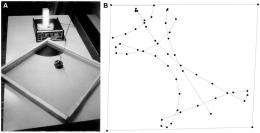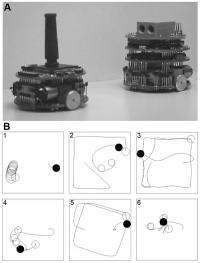February 1, 2010 report
Robots shed more light on evolution (w/ Video)

(PhysOrg.com) -- Swiss scientists have proposed that if robots could evolve through natural selection the result would be robots that would help each other, cooperate, and be capable of hunting. Their experiments follow on from earlier studies reported by PhysOrg, which used robots to shed light on evolutionary processes.
Researchers Laurent Keller, from the University of Lausanne, and Dario Floreano of the École Polytechnique Fédérale de Lausanne studied Alice and Khepera robots controlled by input information from the robots’ sensors and neural networks. They loaded short basic instruction codes into the robots’ operating systems, with random variations that changed every generation, in "virtual mutations". To simulate natural selection, only the code for the most successful robots was selected and passed to the next generation of robots.
In one experiment they programmed robots with six sensors on one side and two on the other to navigate a maze. They then selected the robots most skilled at avoiding collisions. After fewer than 100 generations the robots could navigate through a complex maze without collisions, and had learned to keep the side with six sensors facing in the direction of travel.
In another experiment they programmed groups of robots to push tokens along a wall to a marked area to win points. They selected the robots that gained the most points to pass their code on to the next generation. Over time altruistic behaviors were observed, in which robots sacrificed points if the entire group would benefit, and the robots cooperated to push larger tokens together to earn more points. As in nature, the robots followed the biological principle of kin selection, in which they only helped robots having the same code lineage.
In other experiments some robots with good eyesight were programmed to pursue other robots, which were faster. At first the predators found the prey and headed towards it, while the prey were programmed to move away. After 125 generations, the predators had developed the strategy of lying in wait and attacking the prey robots’ blind spots, while the successful “prey” robots learned where the predators waited and ensured their sensors were always facing the predators.
The code used in the experiments was extremely short, which proves that complex behaviors can emerge from a simple set of instructions. The paper is published in the Public Library of Science -- Biology journal.

More information: Floreano D, Keller L (2010) Evolution of Adaptive Behaviour in Robots by Means of Darwinian Selection. PLoS Biol 8(1): e1000292. doi:10.1371/journal.pbio.1000292
© 2010 PhysOrg.com
















